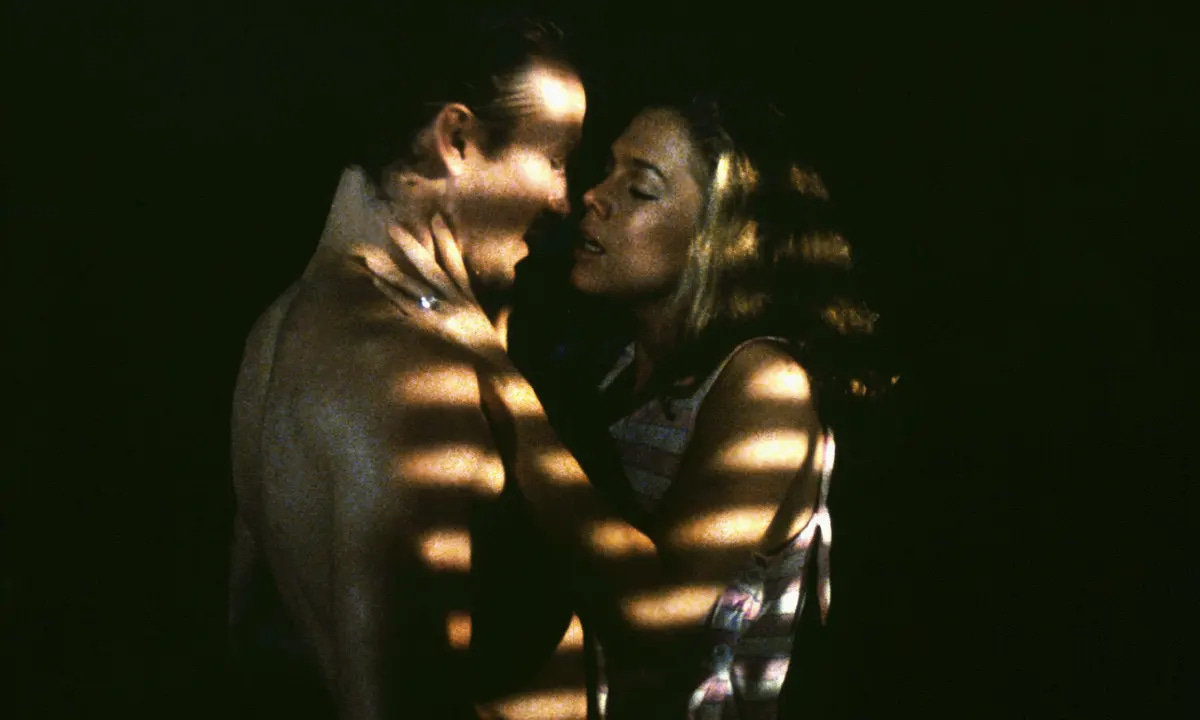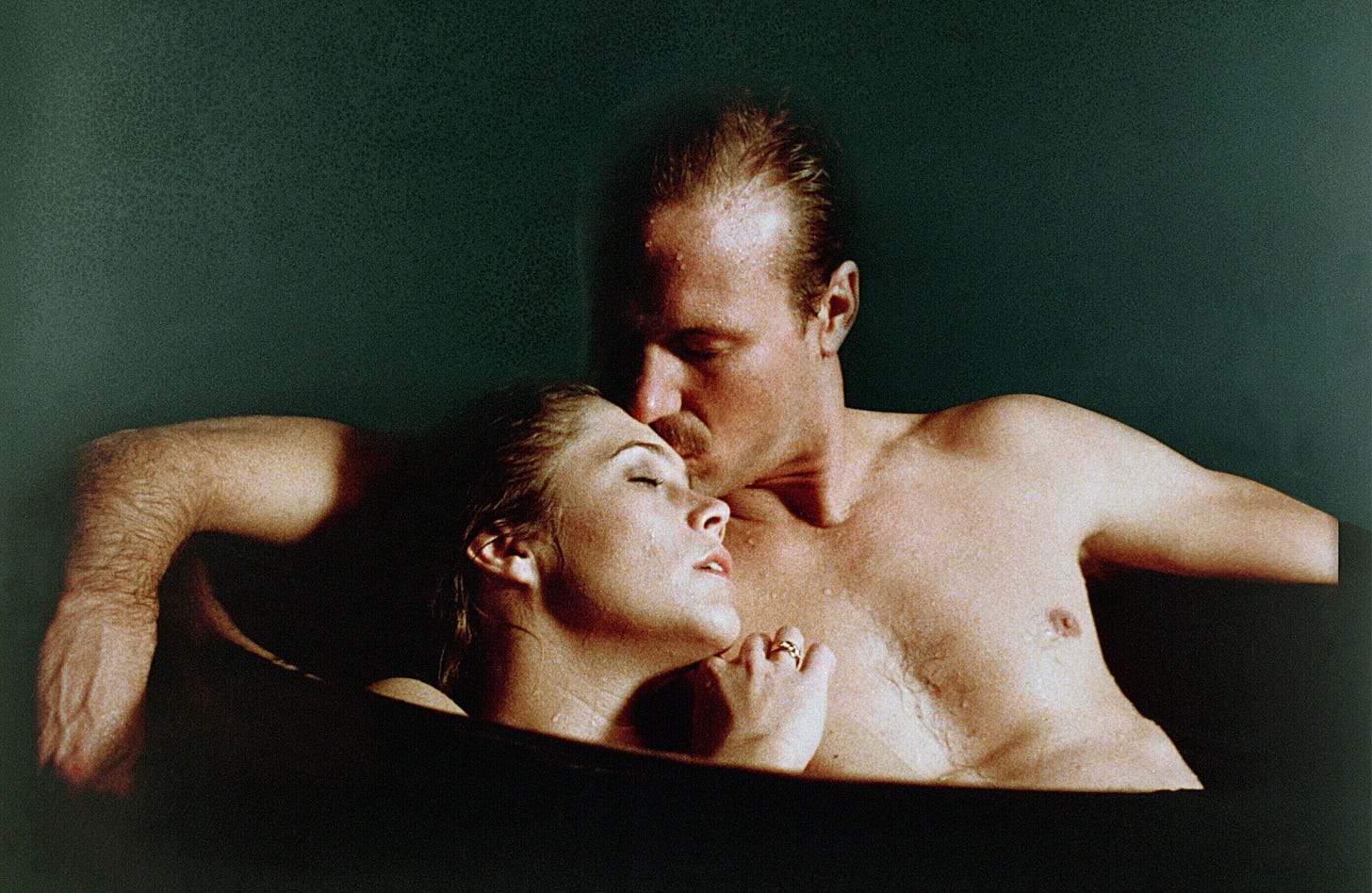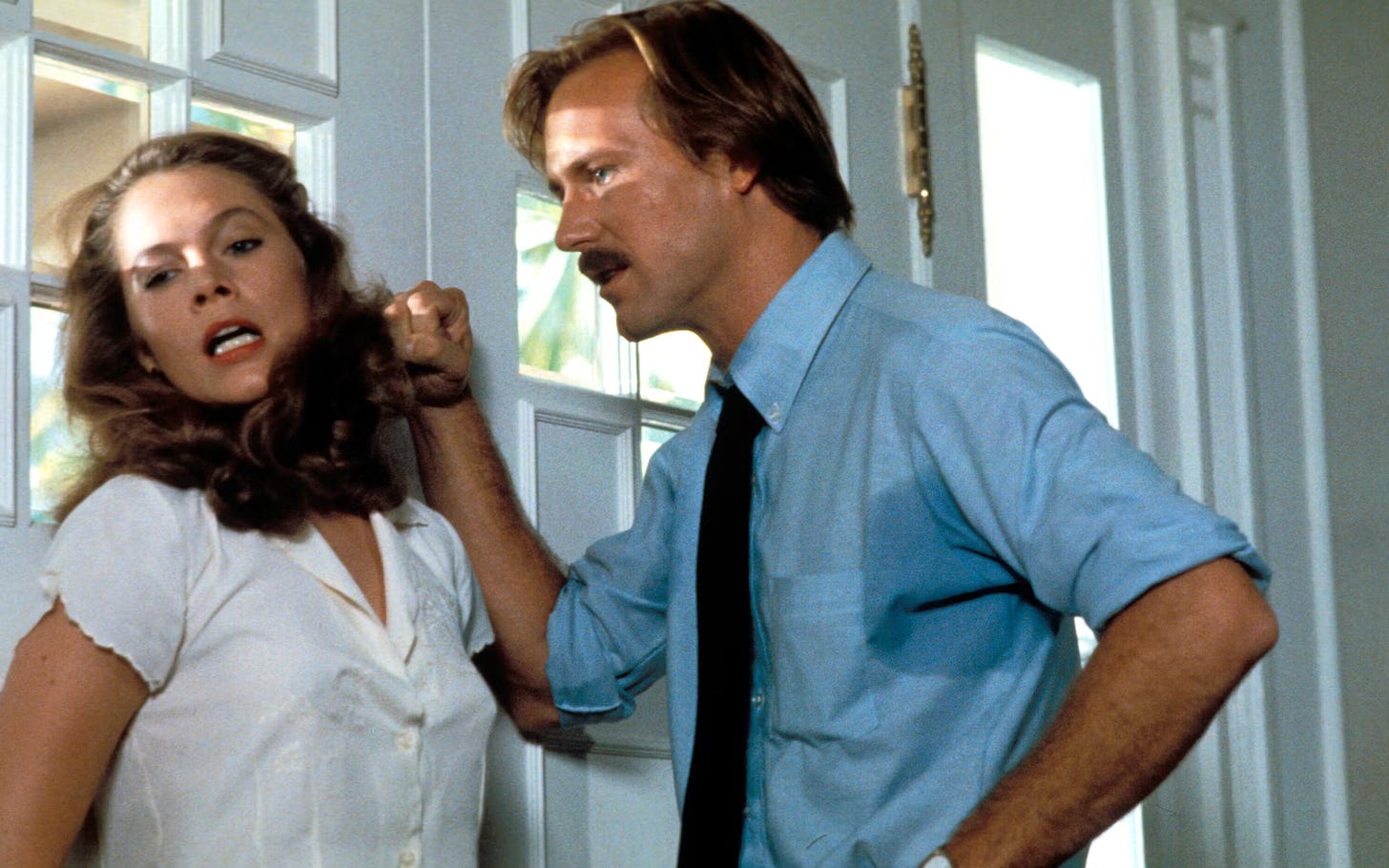The '80s in 40: ‘Body Heat’ (August 28, 1981)
Lawrence Kasdan's 'Double Indemnity' homage confirmed the 1980s as a fertile ground for film noir.
The ’80s in 40 revisits the decade of the 1980s choosing four movies a year, one from each quarter. This entry covers the fourth quarter of 1981.*
Years before I finally watched Body Heat, I encountered it as an object of study. My freshman year of college, I joined a short-lived extracurricular club devoted to pop culture,headed by a chain-smoking, leather-wearing English professor with dim hopes for the future. Though I could never quite share (and often couldn’t understand), his self-declared “post-structuralist” views, , his enthusiasm for literature and what lay below the surface of the text make him probably as responsible as anyone for pointing me toward pursuing criticism as a profession, even if at one point I thought it would be a career devoted to English literature and result in me having campus office hours and a stack of papers to grade. After one year of grad school, I left academia behind and never looked back, but that doesn’t mean much of what I studied there hasn’t stuck with me.
That includes Frederic Jameson’s 1984 essay “Postmodernism, or the Cultural Logic of Late Capitalism,” which attempted to define what postmodernism is and what it means. For an academic text, it’s pretty engaging, offering a sweeping look at the culture of the moment that touches on everything from architecture to painting to literature to film. (Jameson expanded it into a book of the same name in 1991.) Reading it now, I can see it’s far from the description of a wasteland with no future, as my professor interpreted it.. But I also see some limitations, at least in its treatment of Body Heat.
In short: Jameson treats Body Heat as Exhibit A for an exhausted film culture (and by extension, culture at large) that’s been colonized by nostalgia and “increasingly incapable of fashioning representations of our own current experience.” Body Heat’s mood, music, tropes, and even the font used for its credits owe a debt to noir in general and its plot owes more than a little to James M. Cain’s 1943 novel Double Indemnity and the Billy Wilder-directed adaptation of the following year. In Jameson’s view, it’s a work of art that knows only how to recycle.
That didn’t sound quite right to me then and made even less sense to me when I finally watched the film a few years later, having somehow missed it in its years of video store and cable ubiquity. But I can’t help but wonder if this is a matter of generational perspective. Just as my daughter has grown up with digital technology and, consequently, grown adept with it in ways I never will, I grew up in a postmodern world. Pastiche? Homage? Self-awareness? The collapse of “high” and “low” art? None of that seems particularly odd or alarming, or elements of art with nothing to say.
.Beyond that, I’m not sure there’s anything more unusual about a revival of noir in the 1980s than, say, sonnets going in and out of fashion over the centuries. (Did I mention I was an English major?) Film is still a relatively young art, and in noir it found a potent mode of expression defined by its first flowering in the post-war years. But it’s not confined to that era or incapable of adaptation.
The better question would be why noir returned when it did. Karina Longworth addresses this in a 2022 episode of You Must Remember This focusing on Body Heat and Bob Rafelson’s remake of The Postman Always Rings Twice, which arrived in theaters a few months before, and considers why the former was a tremendous success while the latter quickly disappeared (despite the fuss around its explicit sex scenes). The simplest answer: Rafelson’s Postman was graphic without ever being sexy and by staying faithful to the James M. Cain novel that inspired it, particularly Cain’s bleak ending, it was a huge downer. Body Heat certainly didn’t want for sexiness and while its ending can’t be called happy, exactly, it’s hard to feel too bad for the character who ends up on the losing end of it.
Body Heat also exemplifies how adaptive noir could be to different eras, even if its roots would always remain in its golden age. Classic noir was born of the specific anxieties and discontents of the post-war era, a time that promised bright futures for all but only delivered them to some, when gender roles weren’t what they used to be, and where every dark city street seemed to offer an opportunity to sell one’s soul. But its look could be updated for changing styles** and retrofitted for the concerns of other moments.
Body Heat is set in a small Florida city where time has seemingly stood still, though perhaps not for much longer. It opens with an image of fire in the distance as protagonist Ned Racine, dripping in sweat only partly caused by his tryst with the stewardess stepping out of his shower, watches a building he identifies as the Seawater Inn burn. “My family used to eat here 25 years ago,” Ned tells the stewardess. “Now somebody’s torched it to clear the lot,” later adding, “My history is burning.”
Ned’s not really the sentimental type, but this clearly bothers him. Though he might technically have a white collar job in the divide between haves and have-nots, he’s decidedly on the have-not side. That’s at least partly his own doing. Ned’s not, by all evidence, a particularly good lawyer. Whether he caters almost to an exclusively low-life clientele because of this or whether his low-life clientele has limited his upward mobility remains a bit of an open question, but we’ll later find out he has as much in common with the criminals he represents as his best friends, an assistant DA named Peter (Ted Danson) and a police detective named Oscar (J.A. Preston). Ned may also have just found his professional level. As Body Heat’s femme fatale Matty Walker (Kathleen Turner) observes in the film’s most famous line of dialogue, he’s “not too smart.”
Matty then adds, “I like that in a man,” and, as we’ll soon see, she has good reason for that preference. Though the degree to which writer-director Lawrence Kasdan remakes Double Indemnity here is sometimes overstated, anyone familiar with its story—or many other noirs—will see where this is going. After a flirtatious meeting at an outdoor concert inspires Ned to spend his days and nights searching for Matty after she disappears, they begin a torrid and by all appearances—and the film doesn’t really hold much back—mutually satisfying affair. Yes, she’s married, but her husband’s out of town on business during the week and she doesn’t much like him anyway. It’s fine if they don’t take it too far.
They take it too far. Before they embark on a murder plot that will remove Matty’s husband from the picture and leave Matty and Ned to share his wealth, Ned says out loud what neither has said before: “We’re going to kill him. We both know that.” Together, they’ve passed the point of no return. What noir expert Eddie Muller calls “the noir moment” has come and gone and now there’s no turning back. Or at least that’s how Ned sees it. Though Matty doesn’t shy away from talking about how rich they’ll be when the deed is done, Ned never catches on that for Matty this might not be primarily, or even partially, a crime of passion.
The identity of Matty’s husband, and how he got his fortune, is one of the points where Body Heat diverges most notably from Double Indemnity. Where Fred MacMurray and Barbara Stanwyck’s victim is mostly an undeserving dupe, Matty is married to the older Edmund Walker (Richard Crenna), a businessman with dubious connections. Ned and Matty dump his body at a shuttered piece of beachside property that Edmund and his associates have bought with an eye toward redevelopment. Its closure, and their acquisition, is part of the same trend as the fire that opens the film. (Which might also be their work.) When history isn’t burning, it’s being bought up piece by piece.
Not that Ned doesn’t play his part in this process. Watching the fire he suggests to the stewardess that it might be the work of one of his clients. But he also knows that his clients commit crime for profit not pleasure (and later contracts a repeat offender, played by Mickey Rourke, to assist with the murder). And like the criminals he represents, Ned is ultimately powerless compared to men like Edmund. When Ned meets the man he’s cuckolding, Edmund mentions he too holds a law degree. Edmund’s degree is from Yale, he notes, before patronizingly adding that Ned’s alma mater, Florida State, is a good school too. And, despite the advantages Edmund was apparently born into, he still cheats and, most likely, commits even worse acts.
When Peter attempts to warn Ned just how much trouble he’s in late in the film, he says “The more I find out about him, the happier I am he's dead. I figure it's a positive thing for the world.” Thanks to his crimes, Edmund lives in the sort of house a small-time Florida lawyer could only dream of owning. Edmund might not make it out of the film alive but, when the credits roll, Ned’s slipped even further down the social ladder despite his own criminal ventures. He’s not too smart, sure, but that’s not the only factor working against him.
Depictions of the class divide can be found in many classic noirs, but Kasdan’s choice to emphasize it in a film that helped repopularize noir for the ’80s—and consequently help set the stage for Blood Simple and other films—feels pointed and timely for a moment when the government began to lose interest in correcting the cruelties of inequality and the gulf between winners and losers continued to deepen. Kasdan’s film proved noir was relevant to new eras with new players that still offered familiar ways to tumble into the darkness. It’s not that Body Heat has to resort to an old form because it’s incapable of depicting the present in original terms. It’s that the film understands those forms’ continued relevance, and the thinness of the divide between past and present.***
Next: Porky’s
Stripes (June 1981)
Heaven's Gate (April 1981)
Cutter’s Way (March 1981)
9 to 5 (December 1980)=
Ordinary People (September 1980)
Urban Cowboy (June 1980)
Little Darlings (March 1980)
* I cheated a bit on the release date again, but Body Heat was in its widest release in the fall of 1981.
** The largely forgotten 1980 neo-noir Union City has a soft early-days-of-music-videos sheen, for instance. It also stars Deborah Harry and inspired one of Blondie’s best deep cuts.
*** For making it this far, please enjoy SCTV’s typically dead-on parody of Body Heat’s trailer.







This only tangentially related to Body Heat, but me wonder if there was so much sex in movies in 80s and so little of it now because of how fashions have changed. When me was young monster in 80s, young women wore high-necked blouses with shoulder pads, long skirts, big hair; or women embraced counterculture and wore flannel shirts, leather jackets, big chunky boots. Either way,
you had to squint googly eyes very hard to see anything approaching feminine shape.
Whereas now sleveless top is perfectly normal work attire, and if you take stroll through park, women jog by wearing sports bra that mostly just network of thin straps. It no mystery what female body look like in 2023 if you live anywhere outside of Utah. (And that absolutely good thing, for reasons that have nothing to do with me ogling joggers — we live in much better world with less Vitorian-style shame about human body. Monster body completely different story — me have been running around naked on children's television since 1969 and no one have issue with it.)
So in 80s, seeing some skin in movie was exciting, because we not see that much skin (male or female) in our everyday lives. And not it really not that big of deal.
Although, now that me think about it, easy widespread availability of porn probably much bigger factor. But me not would know anything about that! Me only get excited about COOKIES!!!!
I love Body Heat. Some highlights:
1. Mickey Rourke trying to convince William Hurt not to commit the crime, using some of the lines that Hurt has used on him. But Hurt is immovable at this point.
2. Ted Danson explaining the case against Hurt to him, both aware that Danson now knows Hurt is the murderer (but he's his friend first and the D.A. second)
3. The "tightening noose" scenes in which it becomes slowly (too slowly - he's dumb!) clear to Hurt just how much she's sprung a trap and he waded right into it